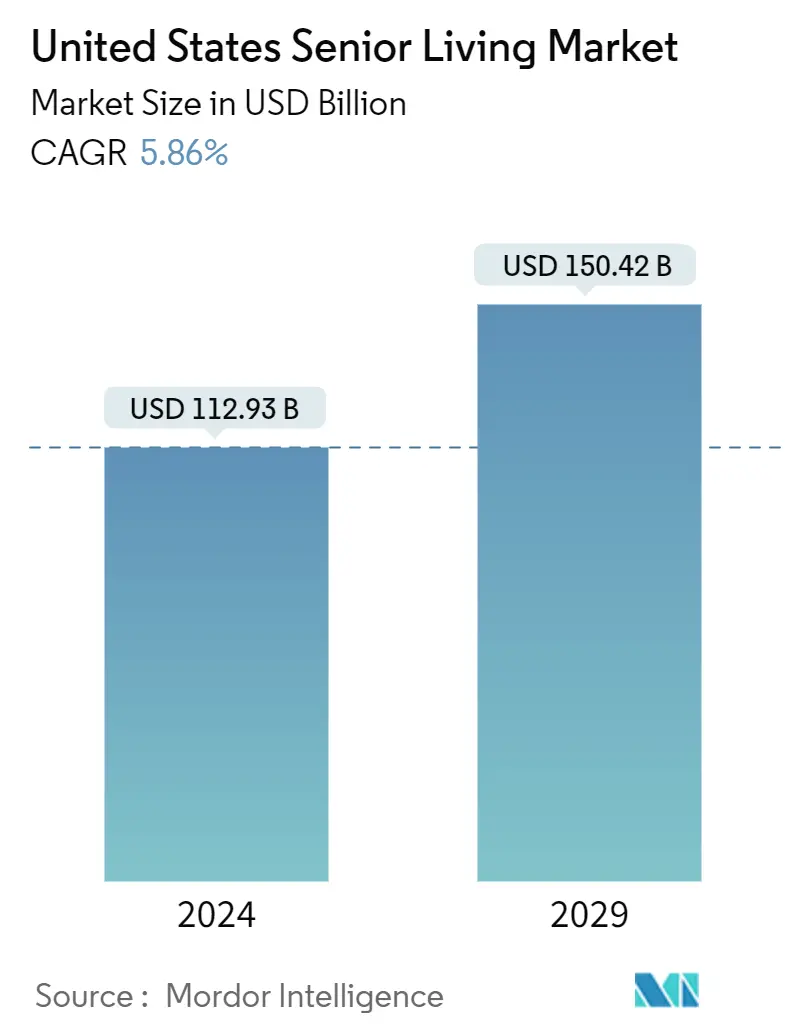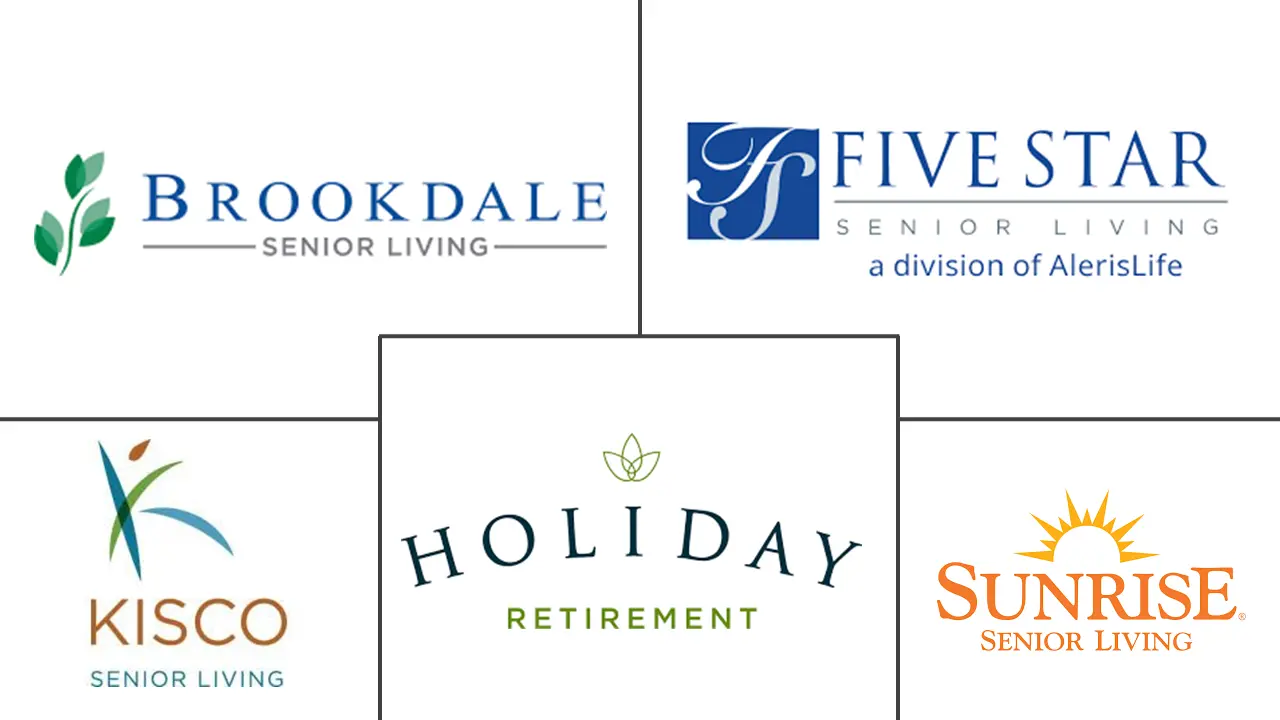Market Size of United States Senior Living Industry

| Study Period | 2020 - 2029 |
| Base Year For Estimation | 2023 |
| Market Size (2024) | USD 112.93 Billion |
| Market Size (2029) | USD 150.42 Billion |
| CAGR (2024 - 2029) | 5.86 % |
| Market Concentration | Low |
Major Players
*Disclaimer: Major Players sorted in no particular order |
United States Senior Living Market Analysis
The United States Senior Living Market size is estimated at USD 112.93 billion in 2024, and is expected to reach USD 150.42 billion by 2029, growing at a CAGR of 5.86% during the forecast period (2024-2029).
- In 2024 and beyond, senior living communities are expected to shift their emphasis from caregiving to wellness, a trend that is expected to continue. Wellness-focused communities offer residents access to fitness facilities, nutrition programs, mental health services, and various social activities. This holistic approach to senior living is expected to enhance senior adults' overall quality of life.
- The U.S. population is projected to age faster than any other age group in the country over the next decade as baby boomers age beyond retirement. In the U.S., over 10,000 people reach the age of 65 every day.
- In particular, the population of people over 80 in the United States is projected to increase by almost 50% over the next ten years, rising from 13.9 million to 20.8 million. This highlights the huge demand for additional senior housing and nursing care. By comparison, the overall population growth in the United States is projected to be a modest 4.7% over the same period.
- Assisted living and independent living properties both experienced significant growth in occupancy rates, accounting for more than 80% and 70%, respectively. In addition, the market experienced the highest occupancy rates in San Jose (83.7%), Portland (83.4%), San Francisco (83.4%), etc. Also, low occupancy rates were noted in Houston (73.0%), Atlanta (74.8%), Las Vegas (74.9%), etc.
- Most of the senior housing communities are present in the Southeast region of the United States, with 3,706 communities, followed by West (3,436), Northeast (3,320), North Central (3,303), and South Central (2,244). The Southeast region includes North Carolina, South Carolina, Tennessee, Georgia, Florida, Alabama, Mississippi, Arkansas, Louisiana, and Texas.
- The Northeast region includes Maine, New Hampshire, Vermont, Massachusetts, Rhode Island, Connecticut, New York, New Jersey, and Pennsylvania. The West region comprises Montana, Idaho, Wyoming, Colorado, New Mexico, Arizona, Utah, Nevada, California, Oregon, Washington, Alaska, and Hawaii.
United States Senior Living Industry Segmentation
The US senior living market provides a wide range of housing and lifestyle options suitable for the needs of an aging population.
The report on the US senior living market includes market dynamics, technological trends, insights, and government initiatives related to the market.
The US senior living market is segmented by property type (assisted living, independent living, memory care, nursing care, and other property types) and key states (New York, Illinois, California, North Carolina, Washington, and the Rest of the United States). The report offers the United States senior living market size in value terms in (USD) for all the segments mentioned above.
| By Property Type | |
| Assisted Living | |
| Independent Living | |
| Memory Care | |
| Nursing Care | |
| Other Property Types |
| By Key States | |
| New York | |
| Illinois | |
| California | |
| North Carolina | |
| Washington | |
| Rest of United States |
United States Senior Living Market Size Summary
The United States senior living market is poised for significant growth, driven by the aging baby boomer population and a shift in focus from traditional caregiving to wellness-oriented communities. These communities are increasingly offering holistic services, including fitness facilities, nutrition programs, and mental health services, which are expected to enhance the quality of life for senior residents. The demand for senior housing and nursing care is on the rise, particularly as the population over 80 is projected to increase substantially. This trend is further supported by high occupancy rates in assisted and independent living properties, with the Southeast region hosting the majority of senior housing communities. The market is characterized by a mix of for-profit and nonprofit entities, with nonprofit communities often achieving higher occupancy rates despite offering fewer amenities.
The senior living market in the United States is highly fragmented, with local and small developers dominating the landscape. This fragmentation has led to intense competition, prompting players to expand through mergers, acquisitions, and strategic partnerships. Major companies such as Brookdale Senior Living Inc., Five Star Senior Living, and Sunrise Senior Living are key players in this space. The market is also witnessing innovations in care, such as the use of AI and remote clinical experts to enhance dementia care. As the demand for nursing care grows, driven by chronic health conditions among seniors, the market is expected to continue its upward trajectory, with significant investments in new facilities and services.
United States Senior Living Market Size - Table of Contents
-
1. MARKET INSIGHTS AND DYNAMICS
-
1.1 Market Overview
-
1.2 Market Dynamics
-
1.2.1 Market Drivers
-
1.2.1.1 Increase in Aging Population Driving the Market
-
1.2.1.2 Healthcare and Long-term Care Needs Driving the Market
-
-
1.2.2 Market Restraints
-
1.2.2.1 High Affordability and Cost of Care Affecting the Market
-
1.2.2.2 Staffing and Workforce Challenges Affecting the Market
-
-
1.2.3 Market Opportunities
-
1.2.3.1 Technological Innovations Driving the Market
-
-
-
1.3 Insights into Technological Innovation in the Senior Living Sector
-
1.4 Government Regulations and Initiatives
-
1.5 Supply Chain/Value Chain Analysis
-
1.6 Industry Attractiveness - Porter's Five Forces Analysis
-
1.6.1 Threat of New Entrants
-
1.6.2 Bargaining Power of Buyers/Consumers
-
1.6.3 Bargaining Power of Suppliers
-
1.6.4 Threat of Substitute Products
-
1.6.5 Intensity of Competitive Rivalry
-
-
1.7 Impact of COVID-19 on the Market
-
-
2. MARKET SEGMENTATION
-
2.1 By Property Type
-
2.1.1 Assisted Living
-
2.1.2 Independent Living
-
2.1.3 Memory Care
-
2.1.4 Nursing Care
-
2.1.5 Other Property Types
-
-
2.2 By Key States
-
2.2.1 New York
-
2.2.2 Illinois
-
2.2.3 California
-
2.2.4 North Carolina
-
2.2.5 Washington
-
2.2.6 Rest of United States
-
-
United States Senior Living Market Size FAQs
How big is the United States Senior Living Market?
The United States Senior Living Market size is expected to reach USD 112.93 billion in 2024 and grow at a CAGR of 5.86% to reach USD 150.42 billion by 2029.
What is the current United States Senior Living Market size?
In 2024, the United States Senior Living Market size is expected to reach USD 112.93 billion.

